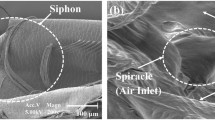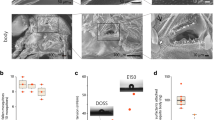Abstract
THE dependence of mosquito larvae and pupae on the air–water interface for respiration suggests several opportunities for insect control. The use of soluble surfactants to vary the surface tension1–3 is reported to have been effective but the substances employed would not be used on water intended for drinking or irrigation. Insoluble monomolecular layers of lauryl alcohol have also been reported4 to be effective against pupae of C. pipiens quinquefasciatus. We now describe the effect of several monomolecular films on mosquito pupae of several species.
Similar content being viewed by others
References
Mulla, M. A., and Chandbury, M. F. B., Mosq. News, 28, 187 (1968).
Russel, P. F., and Rao, T. R., Amer. J. Trop. Med., 21, 767 (1941).
Singh, K. R. P., and Micks, D. W., Mosq. News, 17, 70 (1957).
Lorenzen, G. A., and Meinke, W. W., Mosq. News, 28, 230 (1968).
McMullen, A. I., Hill, M. N., and Cook, A. S., 16 mm cine sound film (CDE Film Unit, Porton, Wiltshire, 1971).
Author information
Authors and Affiliations
Rights and permissions
About this article
Cite this article
MCMULLEN, A., HILL, M. Anoxia in Mosquito Pupae under Insoluble Monolayers. Nature 234, 51–52 (1971). https://doi.org/10.1038/234051a0
Received:
Revised:
Issue Date:
DOI: https://doi.org/10.1038/234051a0
- Springer Nature Limited
This article is cited by
-
Spreading of Bacillus thuringiensis var. israelensis over the water surface by a monolayer carrier
World Journal of Microbiology & Biotechnology (1991)
-
Mode of action of insoluble monolayers on mosquito pupal respiration
Nature (1977)





